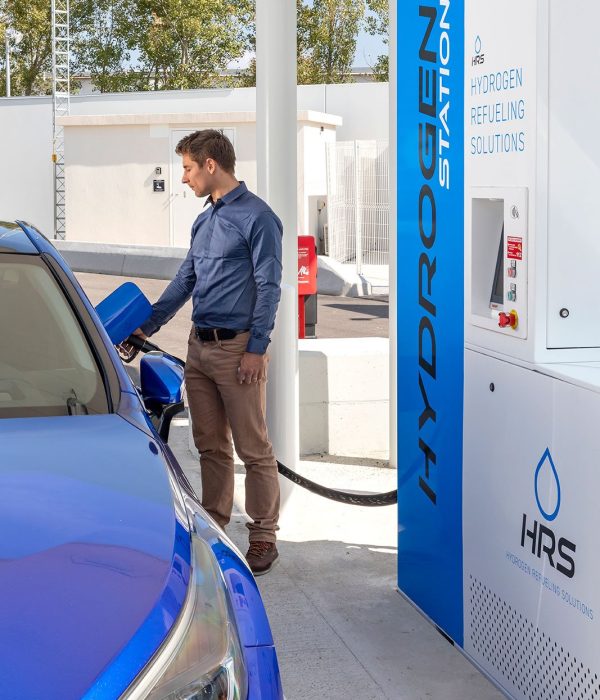Hydrogen, a key part of the transition to zero-emission mobility
A hydrogen vehicle (fuel cell electric vehicle or FCEV) is perfectly suited to use requiring high availability, transportation of heavy loads, long range and/or rapid refueling.
No need to change your driving habits..
A hydrogen vehicle operates in a similar way to existing vehicles. The main difference is that the engine is replaced with a fuel cell.
When you arrive at a station, simply connect the vehicle to the pump. The refueling time and range are equivalent to those of a combustion engine vehicle.

Major implications for development
In a world where 24% of CO2 emissions come from transport2, and faced with the targets of the Paris Agreement to limit the rise in temperatures, it has become vital to adopt low carbon emission technologies.
At global, European, and national levels, governments have stated their intention to deploy low-carbon hydrogen solutions both for industrial applications and on the mobility market. In 2022, around twenty countries published their energy roadmaps, requiring investment approaching a hundred billion dollars..

A high-potential
market
With a growth of 40% between 2024 and 20251, demand for hydrogen in the transport sector is growing rapidly.
Deploying hydrogen mobility solutions requires the simultaneous development of infrastructure and vehicles, which is why developing hydrogen refueling stations with HRS is a real challenge.

Large-scale deployment of all mobility solutions
According to the International Energy Agency1, more than 100,000 FCEV vehicles were on the road worldwide in 2025.
All car manufacturers are positioning heavy-duty mobility as their primary growth driver, according to the Hydrogen Council⁴4. In 2025, 60% of new models were heavy-duty vehicles, and the bus segment grew by 25%.

Strong growth
in hydrogen stations
More than 1,300 hydrogen refueing stations are in service worldwide in 2025 in the world1, representing a 15% increase compared to 2024.
By 2030, nearly 1,000 stations are expected to cover France⁵5 and more than 600 stations in South Korea and Japan. By 2050, it is estimated that 90,000 H2 stations will be installed worldwide⁶.6.

A market backed by local, national, and European governments
While the EU has supported the implementation of hydrogen mobility for years, the ambitions stated in July 2021 as part of the "Fit for 55" climate package express a real desire to accelerate and scale up the sector.
In order to meet the CO2 emissions targets, set by the Paris Agreement, the EU will:
- Set minimum targets for deploying hydrogen refueling stations for hydrogen vehicles (AFIR),
- Redefine the global framework for renewable hydrogen (RED III),
- Introduce a tax framework for hydrogen (ETD),
- Develop sustainable fuels for sea and air transport (ReFuelEU Aviation, FuelEU Maritime).
In line with European advances, the French hydrogen plan of 7 billion euros announced in 2020 also reveals the desire of governments to scale up the industry and develop a green hydrogen sector in France. The priorities relate to decarbonising the industry by implementing a French electrolysis sector and developing low-carbon H2 heavy-duty mobility alongside support for research, innovation, and skills development8.
In 2022, under the France 2030 plan unveiled by Emmanuel Macron, a further investment of 2.1 billion euros, bringing the total to 9 billion euros, was announced to support the development of the hydrogen sector in France.
In 2023, the European Council adopted legislation setting targets for the deployment of stations: 1 hydrogen station every 200 km along the EU's main roads by 20307.
In March 2025, the French government publishes the update of its national hydrogen strategy (SNH II), taking note of the structural developments that have taken place since 2020 in a key value chain for reducing carbon dioxide emissions from a range of heavy industries and high-emitting modes of transport.
"Our ambition is to make France a leading hydrogen nation, at the forefront of technological and industrial challenges.
This is the goal set by the national hydrogen strategy, launched in 2020 by the President of the Republic.
Our objective is to increase our carbon-free energy production by developing a sovereign industrial sector."Marc Ferracci, Minister of Industry and Energy - April 2025
Sources: 1 IEA – Global Hydrogen Review 2025, 2 French Ministry of Ecological Transition, 3 Hydrogen Council – Scaling up, 4 Hydrogen Council – Hydrogen Compass 2025, 5 France Hydrogène, 6 IEA – Net Zero by 2050, 7Council of the European Union 8 French government
Frequently asked questions about hydrogen mobility
How does hydrogen fuel work?
A hydrogen powered vehicle is usually equipped with a fuel cell.
The fuel cell vehicle is an electric vehicle that produces its own electricity on board.
Once the vehicle has been filled with H2 at the refueling point, the hydrogen is stored in the vehicle before it enters the fuel cell. Inside the cell, the H2 reacts with the oxygen (O2 ) in the air to produce water (H20). This reaction generates electricity which powers the engine, as well as steam which is discharged via the vehicle's exhaust.
A vehicle powered by green hydrogen does not emit CO2 or greenhouse gas.
Vehicle manufacturers are also working on hydrogen internal combustion engines.
is there support for the deployment of hydrogen mobility?
Yes and there several:
For the deployment of vehicles:
- Regional and local grants can subsidise the purchase or long-term leasing of hydrogen vehicles.
For the deployment of hydrogen distribution stations:
- The Banque des Territoires' financing offer for public or private players with projects meeting several conditions. It then offers 4 types of financial package (co-financing, direct investment, minority co-investment in the project company (20% to 49%) and quasi-equity contribution).
- European calls for projects such as the one launched as part of the Connecting Europe Facility programme, which has earmarked €1 billion for the deployment of alternative fuel supply infrastructures along the TEN-T network.
- ADEME's regional calls for projects, which have supported the development of hydrogen infrastructure from 2018 to 2023, 91% of the projects supported relate to the transport sector.
- Calls for Hydrogen Valleys projects, such as IMAGhyNE in the AURA region, where a budget of €20m has been allocated.
What are the advantages of the hydrogen fuel cell?
Hydrogen fuel cells are known for their energy efficiency. They can convert hydrogen molecules directly to electricity.
One of its main advantages is that it produces electricity without harmful emissions. When the hydrogen reacts with the oxygen in the air in the cell, it releases only water. This makes it a clean technology, not contributing to greenhouse gas emissions. Fuel cells can be used to power silent vehicles that do not emit vibrations during use.
Finally, cells perform well in extremely cold conditions, at high altitudes and in thin air, as illustrated by the endurance record set by a Hyundai Nexo during a 6-hour drive at an altitude of 2200 m in December 2021. "Hydrogen" versions of snowplough and snow groomers are also being developed to reduce the carbon footprint of winter sports resorts.
Why use hydrogen for mobility?
Hydrogen is a powerful energy carrier with a high energy density: 1 kg of hydrogen is equivalent to 3 kg of petrol.
H2 is better known in its gaseous state for mobility applications. Thanks to its lightness and low density, it can be compressed for use, usually to 700 bar for light vehicles and 350 bar for heavy mobility applications.
Liquid hydrogen also offers advantages for mobility since, in this state, 1 kg of hydrogen is equivalent to 4 kg of petrol. Liquefying H2, on the other hand, requires it to be cooled and stored below its condensation point, at -253°C.
What is a Ultra Low Emission Vehicle (ULEV)?
It is a vehicle weighing less than 3 tonnes (car or van) whose greenhouse gas emissions are equal to or less than 60 grams per kilometre of CO2 and if its energy source is one of the following: Electricity (EL), Hydrogen (H2), Hydrogen-Rechargeable Electricity (HE), Hydrogen-Non-Rechargeable Electricity (HH) and Compressed Air (AC).
In particular, the French government has introduced a greening obligation for fleets of more than 20 vehicles, which will have to include 50% of ULE buses from 2025 and 40% of ULE cars and LCVs from 2030.
The European Union has introduced new regulations on CO2 emissions from new passenger cars, light commercial vehicles and heavy commercial vehicles. By 2035, a a complete ban on sales of new combustion-powered light vehicles and LCVs will be introduced. For heavy vehicles, the regulations stipulate 90% reduction in CO2 emissions from 2040.
What is a retrofit vehicle?
A retrofit vehicle is a combustion engine vehicle in which the engine and fuel tank have been replaced by an electric motor and a battery or hydrogen fuel cell and a tank adapted to store hydrogen.
This principle makes it possible to convert an existing internal combustion engine vehicle to be compatible with hydrogen, without the need for major modifications. This has the advantage of extending the life of vehicles already on the road, while transforming them into zero-emission vehicles.
There are hydrogen retrofitted vehicles on the market, such as trucks, coaches and buses, boats, snow groomers…
What is the difference between a fuel cell and a hydrogen internal combustion engine?
The main difference between a fuel cell and a hydrogen combustion engine is found in the process by which the hydrogen is used.
A fuel cell converts hydrogen and oxygen into electricity and water. This electricity can then be used to supply an electric motor which powers the vehicle.
The internal combustion engine principle involves mixing hydrogen with air in a combustion chamber and igniting it to create a controlled explosion. The explosion generates mechanical energy which is converted into motion, thereby propelling the vehicle.
What is the difference between an electric vehicle and a hydrogen vehicle?
A hydrogen vehicle is an electric vehicle.
Battery electric vehicles (BEV) are powered by charging points connected to the electricity grid;
Fuel cell electric vehicles (FCEV) convert H2 into electricity on board.
The main difference between an electric vehicle and a hydrogen vehicle is in the way in which they store and use energy. Electric vehicles use batteries to store the electricity, while hydrogen vehicles use fuel cells to produce the electricity, and tanks to store it. Electric vehicles require longer recharging times, while the refueling time for hydrogen vehicles is similar to that of petrol vehicles.
The technologies are complementary.
Using hydrogen for mobility can boost the range (500 to 700 km) and reduce the recharging time (by around 5 minutes for a light vehicle). FCEVs are therefore perfectly suited to intensive and continuous use. BEVs may be used as light vehicles to make short journeys, and may be recharged if there are no limits on time.
Hybrid hydrogen/electric vehicles are available on the market: equipped with both a battery and a fuel cell, they benefit from a recharging system that uses an electric power source with the added advantages of hydrogen.
To find out more about the advantages of H2 for mobility, click here.
What are the advantages of the hydrogen solution for transport?
The use of hydrogen as a fuel in vehicles helps to reduce greenhouse gas emissions and atmospheric pollutants. When used in a fuel cell, hydrogen generates electricity and discharges only water. This means it helps to improve air quality and combat climate change.
Hydrogen can be used for all vehicles (cars, buses, trucks, trains, planes, machinery, boats, etc.).
Hydrogen vehicles offer a similar range to that of combustion engine vehicles. Moreover, hydrogen refueling can also be as fast as petrol refueling, requiring just a few minutes to fill a tank. These two points distinguish hydrogen vehicles from battery electric vehicles.
Finally, using decarbonised hydrogen also helps to reduce reliance on fossil fuels, contributing to energy security and the diversification of energy sources.